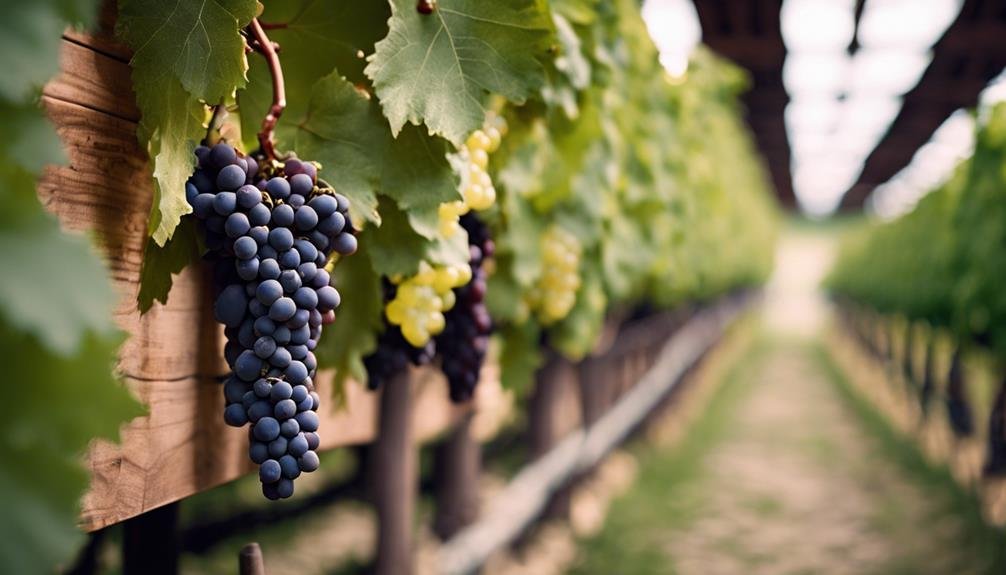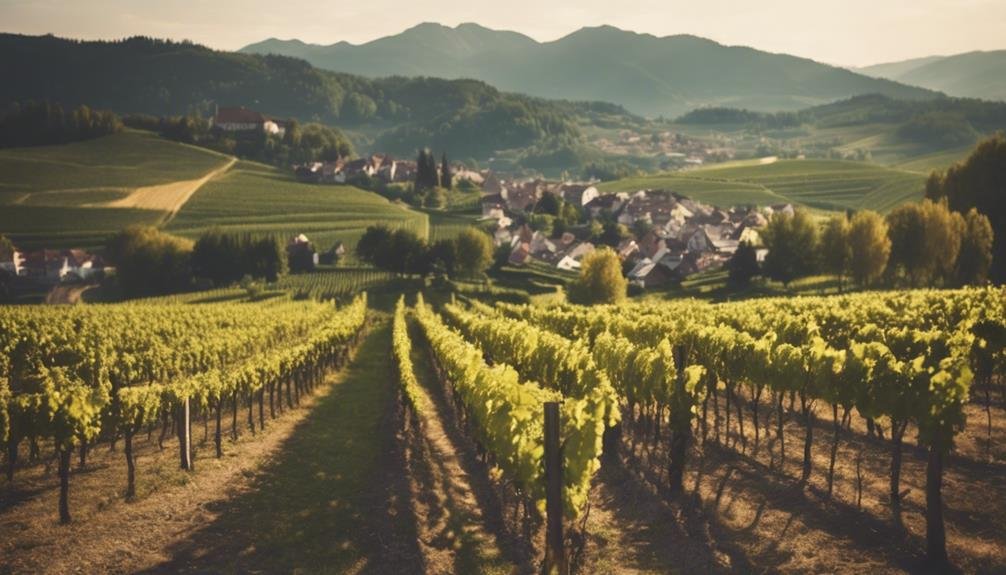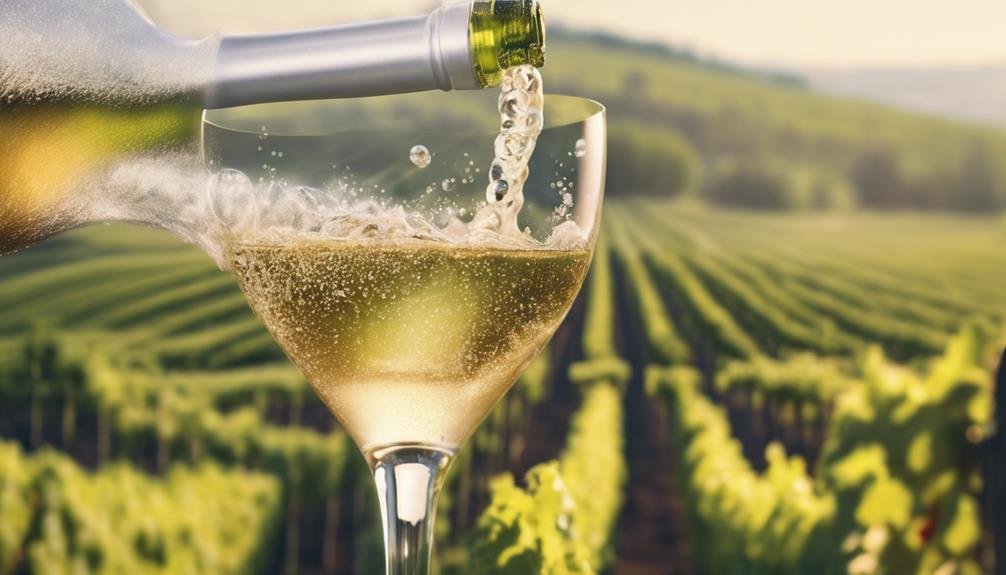The Sekt wine revolution in Germany and Austria signifies a rich history of transformation and excellence, beginning humble in the 1820s with moderate quality but evolving into a force in the global sparkling wine market. Germany and Austria dominate the industry, with Germany emphasizing innovation and Austria holding dear to tradition. Quality improvements are evident in Sekt production through advanced techniques and refined processes, offering diverse high-quality options. The diverse classifications in both countries highlight regional influences, while Austrian regulations set strict quality standards for Sekt. Discover the intricacies of Germany and Austria's sparkling treasures.
Historical Evolution of Sekt Wine
How has the historical evolution shaped the quality and perception of Sekt wine over the years?
The origins of Sekt wine date back to the 1820s, with initial production known for its mediocre quality. Over time, modern advancements in winemaking techniques and quality standards have greatly improved the reputation of Sekt wine.
Both Germany and Austria, as the largest sparkling wine markets globally, have seen a notable shift towards enhancing the production of Sekt. Recent changes in wine governance have also played a vital role in elevating the quality and perception of Sekt wine.
With a focus on refining production methods and ensuring adherence to stringent quality criteria, the historical evolution of Sekt wine has paved the way for a new era of excellence in sparkling wine production.
Market Dominance in Sparkling Wines
With Germany and Austria leading the global sparkling wine markets, their dominance in the production and consumption of Sekt wines underscores a significant shift in the industry. Global competition drives these nations to excel, meeting consumer preferences for quality sparkling wines. Below is a comparison of key aspects of the market dominance between Germany and Austria:
| Aspect | Germany | Austria |
|---|---|---|
| Production Volume | High | Moderate |
| Market Share | Extensive | Growing |
| Consumer Demand | Diverse preferences | Increasing interest in premium wines |
| Export Markets | Well-established in global markets | Focused on expanding export opportunities |
| Innovation | Embracing new techniques and technologies | Committed to traditional methods |
Quality Improvements in Sekt Production

Significant advancements in enhancing the quality standards of Sekt wine production have been evident in both German and Austrian wine markets in recent years. Through the adoption of innovative techniques and the incorporation of emerging trends, the overall quality of Sekt wines has seen notable improvements.
Both countries have been focusing on refining their production processes, such as experimenting with different grape varieties, enhancing fermentation methods, and investing in modern equipment to elevate the quality of their sparkling wines. These efforts have resulted in a more diverse range of high-quality Sekts with improved flavors, aromas, and textures, appealing to a broader audience of wine enthusiasts.
The commitment to quality improvements in Sekt production underscores the dedication of German and Austrian winemakers to elevate their sparkling wine offerings to compete on a global scale.
Diverse Classifications in Germany and Austria
The classification systems for Sekt wines in Germany and Austria offer a diverse range of options for consumers seeking quality sparkling wines with distinct characteristics and origins. In Germany, regional differences play a significant role in the quality of Sekt, with various classifications such as German Sekt, German Sekt b.A., Winzersekt, and Perlwein reflecting these nuances. Each classification emphasizes specific production methods and grape varieties, resulting in a wide array of flavors and styles.
Austrian Sekt also showcases regional diversity, with tiers like Sekt, Austrian Sekt, and Austrian Sekt Klassik highlighting the importance of origin and production techniques. Understanding these classifications allows consumers to explore the rich tapestry of sparkling wines from Germany and Austria, each offering a unique expression of terroir and craftsmanship.
Striving for Excellence: Austrian Sekt Regulations

Austrian Sekt regulations embody strict quality standards that aim to uphold the production and reputation of sparkling wines from Austria. These regulations guarantee that Austrian Sekt meets rigorous criteria, securing a high standard of excellence. Below is a breakdown of the key quality standards upheld in Austrian Sekt production:
| Quality Standards | Description |
|---|---|
| 1. Lees Aging | Austrian Sekt Klassik requires 9 months, while Austrian Sekt Reserve necessitates 18 months. |
| 2. Sourcing | Grapes must originate from Austria's wine regions for both tiers. |
| 3. Production Method | Austrian Sekt Reserve is made using the Traditional Champagne Method. |
Frequently Asked Questions
What Are the Key Challenges Facing Small-Scale Sekt Producers in Germany?
Challenges facing small-scale German Sekt producers include fierce competition, limited access to distribution channels, high production costs, and the need for sustainable practices. Sustainability initiatives are vital for long-term success, ensuring environmental responsibility and economic viability.
How Do Climate Variations Impact the Flavor Profiles of German and Austrian Sekts?
Climate variations play a pivotal role in shaping the diverse flavor profiles of German and Austrian Sekts. These fluctuations influence grape ripening, acidity levels, and sugar content, ultimately impacting the nuanced characteristics and quality of these sparkling wines. Sustainable wine production practices mitigate these effects.
What Role Do Indigenous Grape Varieties Play in the Production of High-Quality Sekts?
Indigenous grape varieties play a pivotal role in high-quality Sekt production by imparting unique flavor profiles and regional characteristics. As producers focus on quality, sustainability, and authenticity, marketing strategies increasingly highlight eco-friendly practices, reflecting emerging trends in the wine industry.
Are There Any Significant Differences in the Marketing Strategies Employed by German and Austrian Sekt Producers?
In the world of sparkling wines, German and Austrian Sekt producers strategically differentiate through marketing tactics, brand positioning, and target demographics to engage consumers. Understanding these nuances is crucial in maneuvering the competitive sparkling wine landscape.
How Do Emerging Trends in Eco-Friendly Practices Influence Sekt Production in Germany and Austria?
Emerging trends in sustainable practices are reshaping Sekt production in Germany and Austria. Producers are innovating in packaging, opting for eco-friendly materials and processes. This shift aligns with consumer preferences for environmentally-conscious products, driving positive change in the industry.
Conclusion
In a world where change is constant, the Sekt wine revolution in Germany and Austria is a sparkling gem.
With a rich history, evolving standards, and diverse classifications, these sparkling treasures are a true proof to quality and innovation.
As the saying goes, 'all that glitters is not gold,' but in the case of German and Austrian Sekts, the shimmering excellence of these sparkling wines is indeed a treasure worth exploring.
